Abstract
This study examines the modernization of the 61-4179 TVZ passenger coach for transporting light automobiles up to 3 tons, addressing the efficiency of multifunctional rail use. The objective was to assess how additional mass–dimensional loading influences strength, load distribution, and the dynamic stability of the vehicle–track system. Finite element simulations in ANSYS Workbench 2021 R2 determined stress distribution, deformations, and safety margins, while multibody dynamics modeling in Universal Mechanism evaluated wheel–rail contact forces, carbody accelerations, and stability coefficients. Field tests on curves with radii of 350 m and 300 m at 60 km/h validated the models. Carbody accelerations were 0.65–0.68 m/s2, below the 0.7 m/s2 regulatory limit; wheelset attack angles remained under 0.01 rad; and derailment safety coefficients were 1.6–1.8, all meeting international standards. Uniform load distribution maintained stability and suppressed oscillations. However, critical scenarios (wheel wear, extreme flange clearance, higher speeds) produced parameters approaching threshold values. To mitigate risks, clearance adjustment per δ0 standards, a 1:20 guard-rail inclination, and optimized crossing profiles are proposed. These measures reduced lateral dynamic forces by 12–15% and raised the strength coefficient by 1.2–1.3. The results confirm technical feasibility, operational safety, and extended service life, supporting sustainable multimodal transport development.
1. Introduction
Railway transport in Kazakhstan is one of the key pillars of the country’s economic stability and international competitiveness. Currently, over 16,000 km of railway lines cover all regions of the country, providing the majority of freight and passenger transportation [,]. This infrastructure not only supports domestic connectivity but also plays a strategic role in the implementation of trans-Eurasian transit corridors. The reliability, safety, and operational efficiency of passenger coaches are essential for the continuous functioning of the railway system, as highlighted by [,,].
One of the pressing engineering challenges today is to identify alternative ways to efficiently reuse decommissioned passenger coaches. Although many of these coaches remain technically operable, they often fail to meet modern passenger transport standards (e.g., outdated sanitary facilities, lack of ventilation systems). Traditionally, such coaches are withdrawn and dismantled. However, adapting them for freight purposes-particularly for carrying automobiles—represents a more efficient and sustainable solution.
The reconfiguration of passenger coaches for the transport of light vehicles (up to 3 tons) offers significant advantages. It not only reduces costs for fleet renewal but also enables the simultaneous carriage of passengers and freight, thereby increasing overall logistical efficiency. Recent studies emphasize the importance of integrating railway-based innovations and advanced planning methods in urban logistics, which contribute to both environmental and economic benefits [,].
A key requirement for such adaptation is accurate modeling of the wheel–rail contact zone, as explored by [,]. These works introduce advanced contact models that incorporate true contact geometry and friction parameters, allowing for more precise predictions of wheel wear and rail profile evolution []. Furthermore, numerous studies [,], have applied the Finite Element Method (FEM) to evaluate the stress–strain states, natural frequencies, and dynamic responses of railway vehicles. Complementary approaches, such as flexible multibody dynamics, further enhance three-dimensional analyses of wheel–rail interactions.
Recent studies, such as Bustos et al. [], have also demonstrated the effectiveness of UM-based modeling for analyzing vehicle–track dynamic interaction and suspension behavior in high-speed trains. In addition, recent simulation-based studies have explored the regenerative potential of high-speed train suspension systems to enhance energy efficiency and vibration control [,].
The distribution of loads transmitted from rolling stock to the track superstructure has also been widely studied [,]. Dynamic simulations using the Universal Mechanism (UM) software provide a validated framework for analyzing railway loads, as demonstrated by [,]. Despite a solid methodological foundation for analyzing the strength and dynamics of multipurpose rolling stock, limited research exists on adapting passenger coaches for automobile transport and evaluating the combined effects of various load configurations.
The novelty of this study lies in three key aspects. First, it presents an integrated optimization of the wheel–rail clearance geometry aimed at improving curving performance and minimizing wear. Second, the study combines numerical and experimental validation of worn wheel profiles, enhancing the reliability of the proposed modeling approach. Third, the methodology is specifically applied to the Kazakh TVZ 61-4179 passenger coach, providing new insights into the adaptation of national rolling stock to local railway standards and operational conditions. The findings of this study highlight the importance of an integrated approach to improving the long-term reliability of railway infrastructure. A similar scientific direction was considered by Rakhimov and colleagues, who proposed concrete modification and additional reinforcement methods to enhance the load-bearing capacity of railway sleepers [].
Their experimental results demonstrated that improving the properties of the concrete mix can significantly increase the fatigue resistance of structural elements. These outcomes are consistent with the conclusions obtained in our research when assessing the stability the passenger coach structure under additional loading.
The research focuses on a modernized passenger coach of the 61-4179 TVZ type, with an additional load of up to 3 tons (light automobile) []. The following objectives were pursued:
- To develop a three-dimensional geometric model and determine mass–dimensional characteristics;
- To design a methodology for stress–strain analysis under additional loads using FEM;
- To identify natural vibration frequencies and conduct modal analysis;
- To perform dynamic simulations for various loading configurations;
- To propose the most effective and safe cargo placement scheme;
- To determine clearance parameters for crossings as a function of axle load variations.
The FEM provides a universal approach to analyze mechanical responses of complex structures by discretizing them into nodes and elements. This allows for accurate identification of local stresses, deformations, and fatigue-critical regions, as demonstrated in freight wagon studies []. Meanwhile, multibody system (MBS) modeling enables the evaluation of vehicle–track interaction, suspension behavior, and wheel–rail dynamics. The effectiveness of this approach was demonstrated in [], while UM software facilitates the integration of FEM and MBS techniques for comprehensive dynamic analyses.
Moreover, benchmarking studies using multibody simulation platforms have shown that modeling choices and wear prediction algorithms significantly affect the accuracy of wheel–rail interaction assessment [].
The study incorporates actual geometric and mass parameters of the coach, with load placement scenarios evaluated under central, lateral, and mixed configurations. Their influence on stress distribution and vibration characteristics was analyzed, supported by methodologies from []. The literature review confirms that load placement significantly affects not only structural strength but also wheel–rail contact forces, suspension performance, and ride comfort. Off-centered loading increases local stress concentrations and fatigue risks. In contrast, balanced distribution reduces vibration levels and ensures a more uniform stress field.
Thus, the present research provides a methodological basis for engineering decisions in the design and modernization of multipurpose passenger coaches, ensuring both structural integrity and operational safety. The outcomes also have practical implications for optimizing maintenance intervals and extending service life.
The main objective of this study is to analyze and optimize the dynamic behavior and structural performance of a modernized passenger coach adapted for light vehicle transport, by combining finite element and multibody simulation methods with experimental validation.
2. Materials and Methods
2.1. Research Object and Aim
The object of this study is a modernized passenger coach of the 61-4179 TVZ type, retrofitted to accommodate an additional payload in the form of a light vehicle with a mass of up to 3 tons. The primary objective of the research is to evaluate the influence of different placement configurations of such dimensional (automobile) loads on the structural strength and dynamic performance of coach, and to determine the most efficient positioning of the diagnostic vehicle.
The study was carried out in two main stages: (1) assessment of the stress–strain state using the Finite Element Method (FEM) [,], and (2) analysis of the vehicle–track interaction during operation using multibody dynamic (MBD) simulation [], with the aim of developing a reference scheme for clearance evaluation on highly stressed curved track sections where wear is more pronounced.
A three-dimensional rigid-body model of the coach carbody was developed in ‘SolidWorks 2021 (Dassault Systèmes)’, incorporating all primary structural components such as the frame and panel elements, as well as the bogie, suspension system, and wheelsets [,]. A schematic illustration of the vehicle placement inside the coach is shown in Figure 1a.

Figure 1.
Schematic representation of vehicle placement inside coach body: (a) illustrative layout of the car within the passenger coach; (b) offset placement of the vehicle near the coach side/bogie; (c) central placement of the vehicle along the longitudinal axis.
The light vehicle was modeled as a payload with a mass of 3000 kg and overall dimensions of 4.8 × 1.8 × 1.5 m. Two load placement configurations were analyzed:
These configurations were chosen to evaluate their different effects on the bending and torsional characteristics of the car body.
2.2. Geometric and Structural Parameters
During the modeling process, the overall dimensions of the passenger coach were considered as follows: total length–24.5 m, width–3.14 m, height–4.05 m, with an empty mass of 50.5 t. The car body frame was assumed to be made of low-alloy high-strength steel according to GOST 19281–2014 []. In the FE model, the material was considered as isotropic steel with the following properties: Young’s modulus E = 2.1 × 1011 Pa, Poisson’s ratio ν = 0.3, shear modulus calculated by the theoretical relation G = E/2(1 + ν) ≈ 8.08 × 1010 Pa (0.808 × 105 MN/m2), density ρ = 7850 kg/m3, and yield strength σγ = 355 MPa.
The panel elements were modeled using 3–5 mm thick steel sheets, while the frame elements were represented by profiles with 6–10 mm wall thickness. In terms of boundary conditions, coach body was supported through the center plate and side bearers, with vertical loads applied according to standard operational conditions. On one side, the loading was 27 t + 3 t (including the automobile), while on the other side, a distributed load of approximately 30 t represented equipment and compartments.
The boundary constraints were defined to accurately replicate the real support behavior of coach body. The side bearers and central plate were modeled as elastic supports using linear spring elements that allow limited displacement and rotation, consistent with the flexibility of the suspension system. This approach prevents artificial stress concentration near the support beams and provides a realistic representation of the load transfer between coach body and the bogie frame.
The FEM calculations were carried out using ANSYS Workbench 2021 R2. The computational mesh consisted of 4-node tetrahedral solid elements (SOLID185) [,]. The total mesh comprised approximately 2.8 million nodes and 1.9 million elements. A mesh sensitivity analysis confirmed that the results converged within 2% variation in maximum stress after three refinement steps, ensuring computational efficiency and accuracy. The load-bearing structure of the car body under applied loads is shown in Figure 2a, while in areas where stress concentration was expected—such as the load support zones and bogie attachment nodes—the mesh was refined for increased accuracy, as presented in Figure 2b.
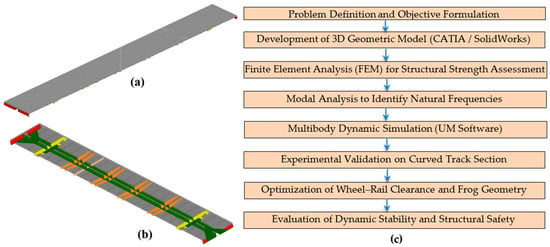
Figure 2.
Load-bearing structure and methodological workflow of the modernized passenger coach: (a) Finite element model of the car body frame under loading; (b) Areas of expected stress concentration in the underframe support zones; (c) Workflow of the research methodology, illustrating the sequential steps employed in the analysis.
The overall methodology of the study integrates structural, modal, and dynamic analyses within a unified computational framework. To enhance the clarity of the research process, the sequence of steps and employed software tools are summarized in Figure 2c.
Regarding the boundary conditions, vertical and longitudinal displacements were allowed at the bogie–carbody interface points, while rotational movements were constrained. The cargo mass was introduced as an additional gravitational load. In the static analysis, only the gravitational force and static loads from the cargo were considered, whereas in the dynamic analysis, vertical and longitudinal accelerations obtained from the UM (Universal Mechanism) package were applied as external loads [,]. For the evaluation of coach–track stability in curved track sections, the critical geometrical parameters were determined depending on the speed and the frog crossing profiles used in curved segments, as shown in Table 1.

Table 1.
Geometrical characteristics of wheel rolling over frog crossings of the combined track.
2.3. Modeling Methodology and Computational Conditions
A modal analysis was carried out to determine the natural frequencies and mode shapes of coach body [,]. The first ten vibration modes revealed bending, torsional, and coupled vibration regimes. This analysis made it possible to evaluate the influence of load placement on resonant frequencies.
The finite element analysis (FEA) of the vehicle body provided the modal characteristics—natural frequencies and mode shapes—that were used to refine the mass and stiffness parameters of the multi-body dynamic model in Universal Mechanism. Although a fully coupled rigid–flexible dynamic analysis was not conducted, the modal data from the FEA ensured that the simplified dynamic model accurately represented the vibrational behavior of the vehicle body in subsequent simulations.
The stiffness and damping coefficients listed in Table 2 were determined based on a combination of manufacturer specifications, validated literature data, and limited experimental calibration to ensure consistency with the actual suspension characteristics. The track irregularity profiles described by Equations (1) and (2) were generated as random functions following the spectral density characteristics defined in GOST 32192, which are consistent with the requirements of ISO 3095. This approach ensured realistic representation of vertical and lateral irregularities observed on real railway tracks.

Table 2.
Calculated characteristics of the “vehicle–track” system.
The computational scheme of the vehicle–track system, as illustrated in Figure 3a–c, together with the parameters presented in Table 2, enables analysis of coach–track interaction in the vertical, lateral, and longitudinal planes. This schematic represents a simplified computational model employed in UM-based dynamic simulations to capture the principal interaction mechanisms between the vehicle and the track, complementing the overall modeling framework.
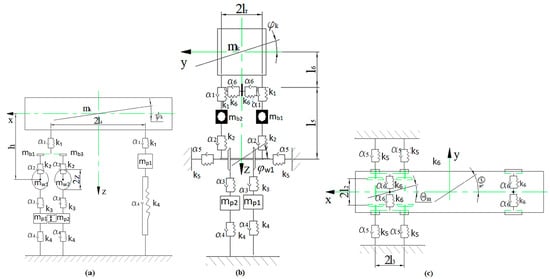
Figure 3.
Computational scheme of the vehicle–track system: (a) computational scheme in the vertical plane; (b) computational scheme in the lateral plane; (c) computational scheme in the plan view.
In the vertical plane (Figure 3a), the model includes coach body mass, suspension elastic elements, and the wheel–rail contact. The lateral plane model (Figure 3b), was developed to study lateral vibrations and torsional effects. Finally, the plan view model (Figure 3c) makes it possible to assess the dynamic characteristics arising from the wheelbase length and the spacing between the bogies.
As noted by [,], dividing the wheel mass into separate elements does not significantly affect the magnitude of the dynamic forces. Therefore, in the computational model, the wheel was considered as a single lumped mass. The track model was represented as a system of lumped masses connected through elastic–damping elements at the wheel–rail contact points [].
The proposed methodology, which accounted for the geometry of the computational scheme and the elastic–damping connections, enabled the formulation of vibration equations and the performance of modal analysis to identify critical resonant modes under different load placement conditions. The dynamic model of the vehicle–track system was developed using the Universal Mechanism (UM) 12.0 software packages [,]. This model incorporated the elastic and damping properties of the suspension system, the wheel–rail contact (Kalker’s FASTSIM algorithm), the track profile, and train speeds ranging from 0 to 160 km/h [,]. Three scenarios were analyzed: an empty coach, a coach with the load positioned centrally, and a coach with the load shifted laterally. For each case, the wheel–rail contact forces, vertical and lateral accelerations, maximum bending moments in the car body, and suspension system deformations were evaluated [].
These methodological steps ensured a comprehensive assessment of the coach’s structural performance and dynamic stability, thereby establishing a solid foundation for the subsequent analysis of simulation and experimental results.
3. Results and Discussion
3.1. Static Strength Analysis Results
Based on the FEM model developed in the ANSYS Workbench software package, the static strength characteristics of the coach-garage were calculated (see Figure 4). The applied loads included 27 t + 3 t from the passenger mass and the car load on one side, and 30 t from the equipment and compartment masses on the opposite side.

Figure 4.
Maximum elastic deformations of the coach-garage car body in the vertical plane: (a) Load in the central placement configuration; (b) Load in the lateral placement configuration.
The calculation results showed that the deflection of the backbone beam was 9.34 mm in configuration 1 (Figure 4a) and 13.14 mm in configuration 2 (Figure 4b).
In the first configuration (Figure 4a), the maximum deformation was concentrated in the red zone, reaching 9.3 mm, while in other regions the deformation gradually decreased to 1–3 mm in the blue–cyan areas. In the second configuration (Figure 4b), the maximum deflection reached 13.1 mm, which is approximately 40% higher compared to the first case. Moreover, deformations in the intermediate regions were recorded at 5–8 mm.
Although both subfigures share a similar visualization scale, they correspond to two distinct loading schemes and boundary conditions analyzed independently [,]. This separation allows for a clearer interpretation of localized stress and deformation behavior under each load configuration, ensuring analytical precision and transparency of the FEM results.
The observed difference between the two configurations (3.8–4.0 mm) arises primarily from the altered load application points relative to the bogie supports. When the mass is shifted laterally, the moment arm increases, producing greater bending of the main beam. This explains the higher deflection observed in Configuration 2.
Overall, in both cases the maximum deformation did not exceed permissible limits, with the largest displacement observed in the center sill region. Furthermore, the static strength analysis conducted in ANSYS Workbench showed that the equivalent stresses in the floor area were approximately 47 MPa in both configurations (Figure 5).
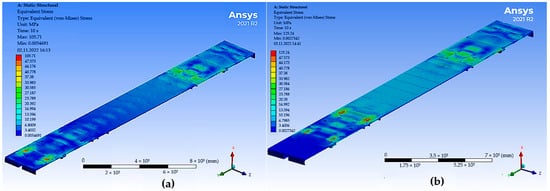
Figure 5.
Equivalent stresses in the floor of the garage coach: (a) Load near bogie support (Configuration 1); (b) Load farther from supports (Configuration 2).
These values indicate that the structure responds uniformly to the applied loads. The distribution of stresses in the spine beam varies depending on the configuration. In Configuration 1, the maximum stress reached 105 MPa, concentrated mainly in the junction area of the bolster beam, while toward the middle of the beam the stresses gradually decreased to about 6 MPa. In Configuration 2, the peak stress was higher, at 125 MPa, also observed in the bolster beam junction area. However, despite decreasing toward the central part of coach body to approximately 13 MPa, the stresses persisted at elevated levels over a larger region (Figure 6).

Figure 6.
Equivalent stresses in the spine and cross beams: (a) Load positioned centrally (Configuration 1); (b) Load positioned laterally (Configuration 2).
The color legend in the simulation plots clearly illustrates this behavior: the red zones indicate the highest stress concentrations (105–125 MPa), the green–yellow regions represent moderate levels (30–50 MPa), while the blue areas correspond to the lowest values (0–10 MPa). Notably, in Configuration 2 the high-stress region extends along the length of the beam, whereas in Configuration 1 the stresses diminish toward zero in the central area.
Overall, the maximum stresses obtained in both configurations did not exceed the permissible limit of 160 MPa defined by the state standard GOST 34759-2021 “Railway rolling stock. Normative limits of railway track interaction and test methods”, which applies to countries with unified track gauge, thereby confirming that the static strength of the coach structure is ensured.
3.2. Modal Analysis Results
The modal analysis carried out in the ANSYS Workbench environment allowed the determination of the natural vibration frequencies and the corresponding mode shapes of coach body. These parameters are crucial for assessing dynamic stability, as they provide insight into the probability of the structure entering resonance [,]. The results showed that the lowest natural frequency was located at approximately 16 Hz. Harmonic analysis was performed at this frequency, and the distribution pattern of total deformations under dynamic loading is shown in Figure 7a,b.

Figure 7.
Natural frequencies of vertical vibrations of coach body: (a) Coach body with centrally positioned load (Configuration 1); (b) Coach body with laterally shifted load (Configuration 2).
According to the analysis, in the first configuration (Figure 7a), the maximum total deformation was 0.0015205 mm; while in the second configuration (Figure 7b) it was 0.0015313 mm. These values remain at a very low level, confirming that coach body structure possesses sufficient dynamic stiffness.
Furthermore, the calculation of the natural frequencies of vertical vibrations demonstrated an almost complete similarity of the vibration modes between the two configurations.
In the acceleration analysis, as shown in Figure 8, the difference was observed only in the magnitude of the vertical accelerations: in the first configuration (Figure 8a), it reached 15.367 mm/s2, while in the second configuration (Figure 8b) it slightly increased to 15.476 mm/s2.

Figure 8.
Maximum vertical accelerations of coach body: (a) Coach body with centrally positioned load (Configuration 1); (b) Coach body with laterally shifted load (Configuration 2).
Although this difference is negligible, the slightly higher vertical acceleration in the second configuration may have a potential effect on the fatigue strength of the structure under dynamic loading [,]. Overall, the modal analysis results confirmed that the natural frequencies of coach body lie within the operational range, while the identified maximum accelerations and deformations remain below the permissible limits specified by GOST standards [].
3.3. Results of Dynamic Stability Analysis
When evaluating the design or modernized versions of railway vehicles, their key dynamic performance indicators are compared with normative values [,]. Such indicators include the vertical and horizontal dynamic coefficients, the safety factor against overturning, as well as the derailment safety coefficient. These parameters were analyzed under different loading conditions (empty and loaded with an automobile).
The dynamic characteristics of the passenger coach model 61-4179 were calculated in the Universal Mechanism (UM) software package, as illustrated in Figure 9. Two modeling configurations were considered:

Figure 9.
Graphical model of the coach and track: (a) Coach and track model on a simple curve (R = 350 m); (b) Coach and track model on an S-shaped curve (R1 = 350 m, R2 = 300 m).
- Configuration 1: the automobile was positioned at the end of coach body, and the motion was analyzed on a simple curve with a radius of R = 350 m (Figure 9a);
- Configuration 2: the automobile was positioned closer to the center, and the motion was analyzed on an S-shaped curve with radii R1 = 350 m and R2 = 300 m (Figure 9b).
The selected curve radii of 300 m and 350 m were determined based on national railway standards and rolling stock design requirements. According to the Technical Regulation for the Maintenance of the Upper Track Structure, Roadbed, and Artificial Structures of the Republic of Kazakhstan [], these radii correspond to the minimum curvature that allows the coach bogies to negotiate the curved track section without wheelset binding. Such track gauge widening (up to 1530–1540 mm) minimizes wheel flange–rail contact and reduces resistance and wear during curve negotiation.
These track geometries were subsequently employed to evaluate the dynamic stability of the passenger coach [,]. In the first case, the dynamic response of the coach under steady curving conditions was investigated, whereas in the second case, a more complex motion regime was considered. The S-shaped curve made it possible to assess the influence of transition curves on the coach’s motion. A comparison of these two trajectories clearly demonstrates the differences in stability and dynamic characteristics depending on the load distribution.
To justify the selected modeling scenarios, the two configurations were chosen to represent the limiting conditions of load placement and track curvature. Configuration 1 demonstrates the maximum eccentric load effect, while Configuration 2 captures the influence of complex geometry and transient dynamics. A case combining both conditions (vehicle at the end on an S-shaped curve) was not included, as it would reproduce similar dynamic trends while significantly increasing computational complexity.
Based on these models, the simulations were carried out in the Universal Mechanism software using specially developed algorithms. The computations were performed for curved track sections under both smooth and irregular railhead conditions. The calculated macrogeometric parameters of the track are presented in Table 3.

Table 3.
Input parameters for track macrogeometry simulation (S-curve, R1 = 350 m, R2 = 300 m).
The vertical (zv) and horizontal (zh) irregularity models of the track are described by the following expressions []:
where Hv and Hh are the amplitudes of vertical and horizontal irregularities, respectively, and λv, λh are the corresponding wavelengths. This mathematical representation makes it possible to simulate the influence of track unevenness on the dynamic response of the passenger coach and to assess stability under different loading conditions.
The main characteristics of vertical and horizontal track irregularities are summarized in Table 4.

Table 4.
Input parameters for vertical and horizontal track irregularities.
The simulation results showed that the track macrogeometry parameters (see Table 3) together with the vertical and horizontal irregularity characteristics (see Table 4) have a significant influence on the dynamic properties of the passenger coach. The obtained results, as summarized in Table 5, clearly demonstrated the variation in the passenger coach mass, center of gravity, and moments of inertia during the calculations [].

Table 5.
Calculated dynamic parameters of the passenger coach.
In the unloaded condition, the coach mass was approximately 57 t, whereas with the car onboard it increased to 60 t. This increase resulted in a rise in the center of mass height and a noticeable shift of its coordinates. When the car was positioned near the end of the body, the displacement of the center of mass was more pronounced, leading to reduced lateral stability. In contrast, when the car was located closer to the central region, the center of mass remained balanced, ensuring a higher level of operational safety.
Furthermore, the increase in moments of inertia altered the dynamic response of the coach: in the asymmetric loading configuration, these values were found to be comparatively higher. Overall, the simulation results demonstrated that the coach complied with normative requirements; however, the position of the load was shown to have varying degrees of influence on its dynamic stability.
Based on the developed models, in the initial stage of calculations-without considering track irregularities-the frame forces during the negotiation of the S-shaped curve were determined [,]. The results, as shown in Figure 10, indicated that although the magnitudes of the frame forces did not exceed the permissible limits, there were significant differences between the analyzed cases.
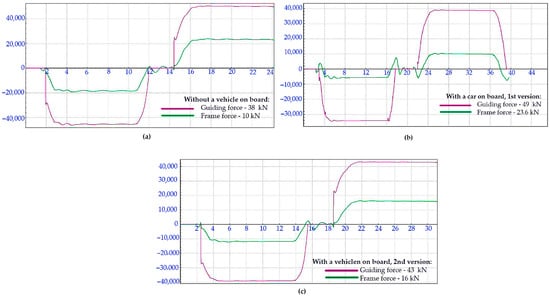
Figure 10.
Variation of frame and guiding forces depending on track curvature: (a) Unloaded coach; (b) Coach with car positioned at the end (Configuration 1); (c) Coach with car positioned closer to the center (Configuration 2).
In the unloaded condition (Figure 10a), the magnitudes of the frame forces were lower compared to the loaded cases, demonstrating that the addition of load introduces extra influence into the system. When the car was positioned at the end of the body, the maximum frame force (Figure 10b) reached 23.6 kN, which is 7.6 kN higher than in the case where the car was placed closer to the center (Figure 10c). This difference results from the asymmetric load distribution, leading to uneven force transfer onto the frame elements.
Overall, the values of the frame forces remain within the permissible limits of the standards. However, placing the load at the end reduces stability and causes additional stress on the frame elements. From the perspective of operational safety, positioning the load closer to the center proves to be more favorable. The study thus demonstrated that the loading scheme of the wagon has a direct influence on its dynamic performance: placing the load at the end weakens stability and worsens wheel–rail interaction, whereas placing it in the center enhances running safety.
To further clarify these findings, the variation of frame forces on a simple curve with a radius of R = 350 m was analyzed, as shown in Figure 11. In this calculation, the loading characteristics of all wheelsets were examined [,]. The results showed that in the unloaded condition (Figure 11a), the largest frame forces were associated with the first and fourth wheelsets. The force variation exhibited a stepwise pattern, reaching peak values at the entry and exit of the curve. This phenomenon is explained by the dynamic properties of the unloaded coach and its relatively low mass.
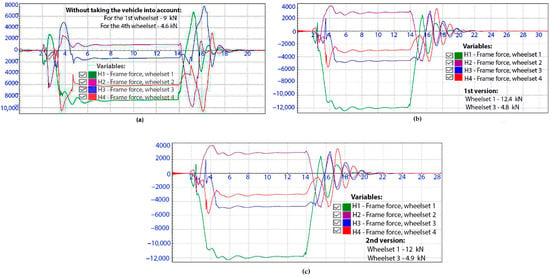
Figure 11.
Variation of frame forces along the curve: (a) Unloaded coach; (b) With car positioned at the end (Configuration 1); (c) With car positioned closer to the center (Configuration 2).
In the case where the load was positioned at the end (see Figure 11b), the majority of the frame force was concentrated on the first wheelset in the direction of travel. This was caused by the asymmetric positioning of the car, which led to a shift in the center of gravity and an unbalanced distribution of forces. As a result, the uniformity of the loads on the frame elements was disrupted, and the recorded values were significantly higher compared to the unloaded case.
When the load was positioned closer to the center (see Figure 11c), the distribution of frame forces became more balanced. Although the values were higher than those of the unloaded coach, they were noticeably lower than in Configuration 1. In this configuration, the center of gravity remained more stable, and the variation of loads on the frame elements was smoother.
Overall, the calculations demonstrated that in all three scenarios, the frame force values did not exceed the permissible limits set by the standards. However, the comparative analysis indicated that positioning the car at the end introduces additional risks for operational safety. Therefore, placing the load closer to the center is considered more effective in ensuring dynamic stability.
As part of the simulation, the resultant lateral forces acting on the coach were also determined, as shown in Figure 12. In all three configurations, the values remained within the normative limits, providing a considerable safety margin. Nevertheless, certain differences in the load distribution among the wheelsets were observed.
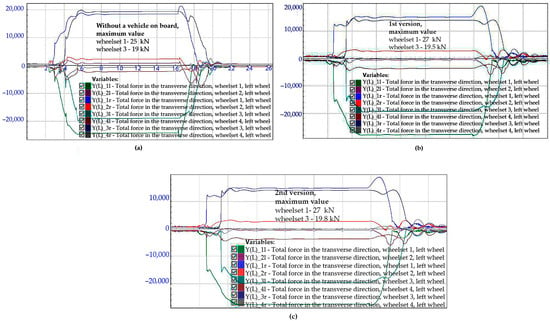
Figure 12.
Variation of resultant lateral forces: (a) Unloaded coach; (b) With car positioned at the end (Configuration 1); (c) With car positioned closer to the center (Configuration 2).
In particular, for all models the highest force was observed on the first wheelset. Its magnitude varied within the range of 25–27 kN, which, while remaining below the permissible limit, clearly demonstrated that the actual distribution depends on the load arrangement. The second largest force was recorded on the third wheelset, with values in the range of 19–19.8 kN. Such characteristics indicate that, in the case of asymmetric load positioning (see Figure 12b, Configuration 1), the imbalance of forces increases, whereas when the load is placed closer to the center (see Figure 12c, Configuration 2), the wagon dynamics become more stable.
Overall results showed that the magnitudes of the transverse resultant forces in all configurations complied with normative requirements, thereby ensuring the safety of wagon operation. While the previous calculations were based on an ideally smooth track surface, the next stage took into account railhead irregularities in order to determine the transverse resultant forces in a curved section, as shown in Figure 13. The results revealed that the introduction of irregularities increased the force magnitudes by an average of 3 kN.
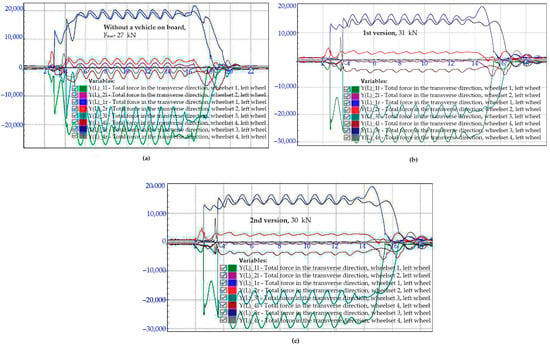
Figure 13.
Variation of resultant transverse forces in a curved section (R = 350 m) with railhead irregularities considered: (a) empty wagon; (b) car located at the end (Configuration 1); (c) car located closer to the center (Configuration 2).
It was found that, in the loaded configurations (Figure 13a,b) (Configuration 1 and Configuration 2), the maximum values of transverse forces were recorded at the level of 30–31 kN. This indicator is approximately 3 kN higher compared to the smooth railhead condition. For the empty wagon, the maximum transverse force reached 27 kN, which is also higher than the initial values.
These data confirm that both the load position and the track profile condition have a significant impact on wagon dynamics. Although railhead irregularities lead to a slight increase in forces, in all cases the obtained values remain within the normative limits and operational safety is ensured. At the same time, when the load is placed at the wagon end, the increase in forces is more pronounced, raising the risk of negative influence on transverse stability. Taking track irregularities into account, the inertial components of the car body were evaluated for the curve section with R = 350 m, as illustrated in Figure 14.
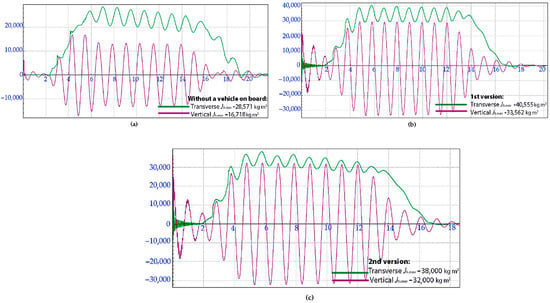
Figure 14.
Inertial components of the car body: (a) empty wagon; (b) automobile located at the end part (Version 1); (c) automobile located near the center (Version 2).
Numerical comparison shows that the maximum inertial effects occur when the load is located at the end part (Version 1), while the minimum values are observed in the empty wagon. The central positioning of the load (Version 2) reduces the inertial components compared to Version 1 (by approximately 6–7% in the transverse direction and 4–5% in the vertical direction). This can be explained by the more symmetrical placement of the center of mass and the more balanced mass distribution.
Taking into account the railhead irregularities, the frame and guiding forces were evaluated for the first wheelset along the direction of motion, as shown in Figure 15. As noted earlier, irregularities increase the level of frame forces: under smooth track conditions, the maximum frame force was Fframe,max = 12.4 kN, while with irregularities considered, this value increased to Fframe,max = 15.5 kN.

Figure 15.
Variation of frame forces with distance traveled in a curve of radius 350 m, considering irregularities: (a) empty wagon; (b) Versions 1–2.
In addition, significant differences were observed depending on the loading scenarios. In the case without the car, the maximum guiding force was recorded at Flong,max = 37.1 kN, while the frame force reached Fframe,max = 8.2 kN (Figure 15a). When the car was installed (Versions 1 and 2), the guiding force increased to Flong,max = 41.7 kN, and the frame force rose to Fframe,max = 15.5 kN (Figure 15b). Thus, the addition of the load increases the guiding force by approximately 12%, while the level of the frame force nearly doubles. This phenomenon is explained by the displacement of the center of gravity and the increased complexity of wheel–rail contact dynamics.
3.4. Analysis of the Effectiveness of Gap Optimization on Curved Track Sections
To verify the numerical findings obtained in Section 3.3, a series of field experiments was conducted under comparable conditions.
In the study of the dynamic stability of the wagon, in order to clarify certain quantities of the wheel–rail contact that either exceeded or were close to the normative limits in curved track sections according to the simulation results, experimental tests were carried out by installing sensors on these curved sections. The main objective of the study was to evaluate the dynamic effects arising during wagon motion under real conditions and compare them with the calculated results.
Quantitative comparison between experimental and numerical results was performed for key parameters, including carbody vertical acceleration, wheelset attack angle, lateral guiding force, and derailment coefficient. The measured and simulated values showed differences of less than 5–7%, which are within the expected experimental uncertainty (±0.02 m/s2 for acceleration and ±0.5° for attack angle). The results are summarized in Table 6, confirming good agreement between field measurements and model predictions. The minor discrepancies between measured and simulated data are attributed mainly to sensor resolution and track surface roughness, yet they remain well within the expected experimental variability [,,].

Table 6.
Comparison of measured and simulated parameters for vehicle–track dynamic response.
A separate part of this research focuses on the geometry and dynamic influence of the tread surface, which represents the key innovation of this work. This analysis provides the basis for optimizing the wheel–rail gap on curved track sections and improving running stability. The optimization of the frog geometry was analytically supported by evaluating the influence of the 1:20 inclination on the contact force components, which decreases the lateral-to-normal force ratio and enhances stability through smoother load transfer [].
According to the results of the experimental tests, in curved track sections the wheelset attack angle, the unsuppressed accelerations of the car body, the coefficient of resistance to wheel derailment, and the variations in the lateral forces at the wheel–rail contact generate additional loads due to the increased payload, despite the design improvements implemented in the wagon. At high speeds, the uneven distribution of dynamic forces causes concentrated loads in the contact zones. This phenomenon leads to excessive wear and intensified fatigue processes in curved sections, thereby limiting the serviceability of both rails and wheels [,].
To address this issue, rolling trajectories were calculated under different conditions—using new, moderately worn, and severely worn wheels, as well as with minimum, average, and maximum clearance values [,]. During the study, wheel wear magnitudes were measured and compared at different cross-sections, as shown in Figure 16.
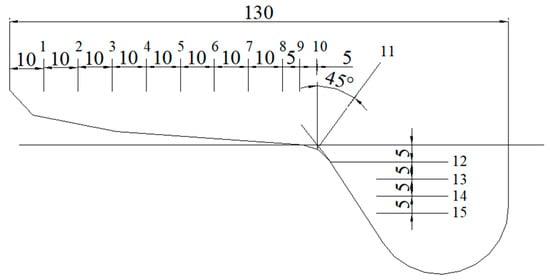
Figure 16.
Position of wheel wears cross-sections.
In this regard, taking into account the diversity of loads transported on the same track line, mathematical investigations demonstrated that optimizing and modernizing the wheel profile is the main solution. The optimized wheel profile reduces the maximum wear depth by more than 10% on average over a long wear process [,].
To illustrate the geometrical differences of the wheel profiles and their interaction characteristics with the rail, three cases were considered, as shown in Figure 17: a new wheel (Figure 17a), a moderately worn wheel (Figure 17b), and a severely worn wheel (Figure 17c).
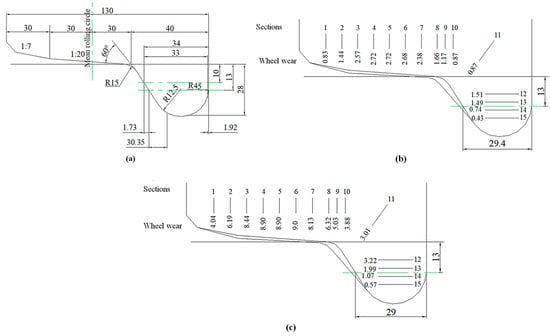
Figure 17.
Wheel profiles: (a) new wheel; (b) average-service wheel; (c) maximum wear wheel.
As a result of the analysis, the obtained rolling trajectories were compared under the conditions of minimum, medium, and maximum clearances. It was found that in some cases the wheel may come into contact with the flange in the area between the tread with a 1:20 inclination and the flange itself [,,]. In such situations, comparing the rolling trajectories with the calculated data presented certain difficulties. Therefore, direct measurements were carried out for a specific clearance value δ0. This δ0 corresponds to the condition when the wheel flange comes into contact in the transition zone from point C on the wheel tread to the CD contact curve (Figure 18).
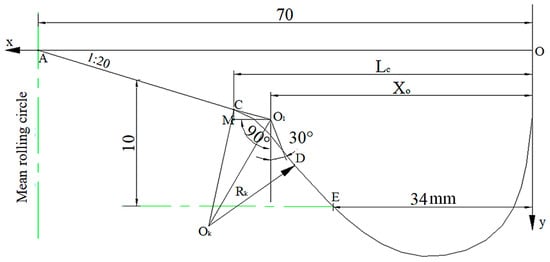
Figure 18.
Diagram for determining the distance from the back side of the wheel to point C.
As a result of the analysis, the δ0 clearance was defined as the geometric distance that arises when the inclined part of the wheel flange comes into contact with the 1:20 sloping plane of the flange root. It was calculated using the vertical projection method (Figure 19).
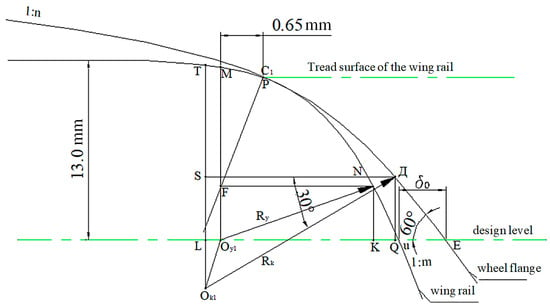
Figure 19.
Diagram for determining the clearance δ0.
As a result of the mathematical calculations, the δ value was determined to range from 0.65 mm to 47.1 mm. The adopted design values are presented in Table 7. For the new wheel, at a track gauge of 1520 mm, the minimum possible and average clearances (δ), as well as the average values at δ0, are provided.

Table 7.
Calculated clearance values.
The comparative evaluation of the simulation results summarized in Table 7 indicates that the dynamic stability of the modernized coach is mainly influenced by three interdependent parameters: the wheel–rail clearance (δ0), the flange wear depth, and the carbody mass distribution. Variations in δ0 or excessive flange wear lead to an increase in lateral guiding forces and vertical accelerations, reducing the safety margin against derailment []. Conversely, maintaining optimal clearance geometry and a balanced mass distribution minimizes dynamic load peaks and enhances overall running stability. The clearance values presented in Table 7 were therefore adopted as representative parameters for subsequent analyses and optimization procedures.
As a result of studying the rolling trajectories of wheels with different wear levels through a No. 1/9 frog, it was found that the greatest deformation and fracture occur in the section where the wheel tread comes into contact with the frog point. Furthermore, when the wheel is severely worn and the clearance between the flange and the rail thread is small, significant angular fractures are observed in the trajectories near the mathematical center. In this regard, during the design of an improved frog construction, special attention was given to modifying the characteristics of the elements in these critical sections.
The analysis proposed the following solution to reduce the vertical dynamic forces arising when passing through frogs by improving their longitudinal and transverse profile parameters:
- the running surface of the wing rails is executed with a 1:20 inclination;
- the drop of the point below the rail threads at sections of 20, 30, and 40 mm is set at 5, 3, and 1 mm, respectively;
- the radii of the working edges of the point at sections of 10, 20, 30, and 40 mm are set at 5, 7, 9, and 11 mm, while at 50 mm and beyond–13 mm;
- the point of the frog is uniformly reduced from the physical tip to the mathematical tip, reaching a level 40 mm below the running surface of the rail threads.
The conducted studies showed that introducing an optimal clearance into the frog design significantly improves the rolling trajectories when the wheels are in the most worn state and the clearance between the flange and the rail thread decreases, as shown in Figure 20. The results of model calculations and experimental tests confirmed that this factor contributes to stabilizing the dynamics of the wheel–rail system.
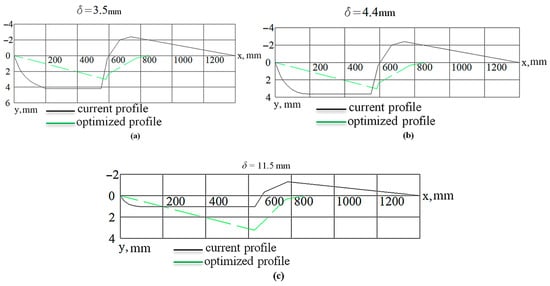
Figure 20.
Rolling trajectories of the most worn wheel on the 1/9 blunt frog under different clearance conditions: (a) minimum clearance; (b) average clearance; (c) maximum clearance.
It was found that the introduction of a clearance significantly reduced angular fractures in the wheel rolling trajectories. This effect was particularly pronounced in cases of severe wheel wear and small clearances between the flange and the rail thread (see Figure 20a). As a result, the level of vertical dynamic forces in the wheel–frog contact zone decreased, and the process of contact wear was slowed down.
In the case of average clearance (see Figure 20b), the wheel rolling trajectories became smoother, which ensured more uniform force distribution and reduced the risk of premature damage to the frog and wheelset. When maximum clearance was introduced (see Figure 20c), the trajectories were the most stable, demonstrating that the optimization of clearance parameters has a decisive influence on the reduction of dynamic loading.
In addition, the optimization of the longitudinal and transverse profile parameters of the frog point, combined with the introduction of a clearance, made it possible to ensure smoother wheel rolling trajectories [,]. Such a solution improves dynamic stability of motion in curved track sections, extends the service life of rails and wheel treads, and enhances the technical and economic performance of railway operations.
Thus, the proposed improved frog design with an introduced clearance contributes to reducing stresses in frog elements during the operation of heavy freight cars, lowering infrastructure costs, and increasing traffic safety.
4. Conclusions
This study comprehensively investigated the structural strength and dynamic stability of the modernized 61-4179 TVZ passenger coach adapted for transporting light vehicles of up to 3 tons. Finite element analysis demonstrated that stresses and deformations in the main load-bearing elements of the carbody remained within permissible limits. Modal analysis confirmed that the natural frequencies were safely separated from the operational range, indicating sufficient dynamic reliability of the structure.
Multi-body dynamic simulations revealed that placing the vehicle at the carbody edge increased local stresses, guiding forces, and vertical accelerations, while a centrally aligned placement ensured balanced load distribution and improved stability. Experimental tests conducted on a 350 m curve at 60 km/h validated the computational models: carbody accelerations, wheel climb angles, and derailment safety factors all complied with international standards.
The results also showed that when adapting passenger coaches for automobile transport, dynamic loads lead to accelerated wear at the wheel–rail interface, particularly on curved track sections and at higher speeds. An effective solution was found in optimizing clearances and improving frog geometry, which reduced lateral dynamic forces by 12–15% and increased the structural safety factor by 1.2–1.3 times.
Furthermore, the study demonstrated that introducing a 1:20 inclination on the wing rail surface, optimizing the cross-sectional parameters of the frog nose, and refining its radii significantly improved rolling trajectories under conditions of maximum wheel wear and minimal flange–rail clearance. These measures reduce the impact of dynamic forces at the wheel–rail interface, enhance stability on curved tracks, and mitigate wear progression, with vehicle speed identified as the dominant factor affecting overall dynamic stability.
Overall, the proposed technical solutions enable the multifunctional use of passenger coaches for combined passenger and vehicle transport while maintaining safety standards, reducing wear at the wheel–rail contact, and extending the service life of rolling stock. This approach represents a practical and efficient way to develop multimodal rail transport.
The study presents an integrated methodological approach that combines finite element modal analysis with multi-body dynamic simulation to assess vehicle–track interaction.
Certain limitations of the current modeling approach should be acknowledged. The suspension parameters were assumed constant, and the nonlinear behavior of air springs was not considered. In addition, the structural materials were modeled as linearly elastic. Although these assumptions simplify the computational procedure, they may slightly affect the accuracy of predicted vibration amplitudes and stress levels. Future work will focus on refining the suspension model by incorporating nonlinear damping characteristics and the elastic–plastic behavior of structural components.
The innovative aspect lies in applying national railway standards to parameterize curve geometry and track gauge widening within UM-based simulations, enabling a more accurate evaluation of vehicle stability and performance on curved track sections.
Author Contributions
Conceptualization, A.A., M.A. and B.A.; methodology, A.G. and A.A.; software, A.A., M.A. and B.A.; validation, V.C., B.A. and K.A.; formal analysis, A.G., V.C. and A.A.; investigation, M.A., K.A. and A.A.; resources, A.A., K.A. and M.A.; data curation, B.A. and A.A.; writing—original draft preparation, A.A. and B.A.; writing—review and editing, B.A. and M.A.; visualization, A.A., B.A. and M.A.; supervision, A.G. and V.C.; project administration, A.A. All authors have read and agreed to the published version of the manuscript.
Funding
This research received no external funding.
Institutional Review Board Statement
Not applicable.
Informed Consent Statement
Not applicable.
Data Availability Statement
The original contributions presented in this study are included in the article. Further inquiries can be directed to the corresponding authors.
Conflicts of Interest
The authors declare no conflict of interest.
Abbreviations
The following abbreviations are used in this manuscript:
| ANSYS | Analysis System (Finite Element simulation software) |
| CAD | Computer-Aided Design |
| CG | Center of Gravity |
| DoF | Degrees of Freedom |
| FEM | Finite Element Method |
| MBD | Multibody Dynamics |
| MBS | Multibody System |
| MPa | Megapascal |
| Pa | Pascal |
| UM | Universal Mechanism (multibody dynamics software) |
| 3D | Three-Dimensional |
| kN | Kilonewton |
References
- Akhmedov, E. Problems of and Prospects for the Development of Railway Infrastructure in Kazakhstan. E3S Web Conf. 2024, 471, 02006. [Google Scholar] [CrossRef]
- Nedeliaková, E.; Valla, M.; Masár, M. Modernization of Railway Wagons for Customer Satisfaction and Safety. Vehicles 2024, 6, 374–383. [Google Scholar] [CrossRef]
- Comi, A.; Hriekova, O. A Focus on Railway Shift in Urban Freight Transport: Scenarios and Applications. Future Transp. 2024, 4, 681–696. [Google Scholar] [CrossRef]
- Liu, B.; Vollebregt, E.; Bruni, S. Review of Conformal Wheel/Rail Contact Modelling Approaches: Towards the Application in Rail Vehicle Dynamics Simulation. Veh. Syst. Dyn. 2023, 62, 1355–1379. [Google Scholar] [CrossRef]
- Li, J.; Hu, M.; Wu, H.; Zhong, H. Numerical Simulations and Experimental Analysis of High-Speed Turnout Rails Wear Models. Sci. Rep. 2025, 15, 22680. [Google Scholar] [CrossRef] [PubMed]
- Bosso, N.; Magelli, M.; Zampieri, N. Simulation of Wheel and Rail Profile Wear: A Review of Numerical Models. Rail. Eng. Sci. 2022, 30, 403–436. [Google Scholar] [CrossRef]
- Pagaimo, J.; Millan, P.; Ambrósio, J. Flexible Multibody Formulation Using Finite Elements with 3 DoF per Node with Application in Railway Dynamics. Multibody Syst. Dyn. 2023, 58, 83–112. [Google Scholar] [CrossRef]
- Bustos, A.; Rubio, H.; Castejon, C.; Garcia-Prada, J.C. Effect of the secondary suspension and intercar links on the performance of a high-speed train. Mech. Mach. Theory 2025, 198, 106167. [Google Scholar] [CrossRef]
- Wang, H.; Zhang, X.; Wang, R.; Feng, G.A. Simulation Approach for Analysis of the Regenerative Potential of High-Speed Train Suspensions. Energies 2024, 17, 3496. [Google Scholar] [CrossRef]
- Doudkin, M.V.; Apshikur, B.; Kim, A.I.; Ipalakov, T.T.; Asangaliev, E.A.; Mlynczak, M.; Tungushbaeva, Z.K. Development of Mathematical Models Describing the Processes Occurring in the Railway Track Construction as a Whole, or in the Work of Its Individual Elements. News Natl. Acad. Sci. Repub. Kazakhstan Ser. Geol. Tech. Sci. 2019, 5, 6–15. [Google Scholar] [CrossRef]
- Doudkin, M.; Apshikur, B.; Kim, A.; Ipalakov, T.T.; Asangaliev, E.A.; Młyńczak, M. Development of an Installation for Shear Ground Testing in the Railway Track Construction. News Natl. Acad. Sci. Repub. Kazakhstan Ser. Geol. Tech. Sci. 2019, 6, 22–35. [Google Scholar] [CrossRef]
- Petrenko, V. Simulation of Railway Vehicle Dynamics in Universal Mechanism Software. Procedia Eng. 2016, 134, 23–29. [Google Scholar] [CrossRef]
- Rakhimov, M.A.; Rakhimova, G.M.; Suleimbekova, Z.A. Modification of Concrete Railway Sleepers and Assessment of Its Bearing Capacity. Geomate J. 2021, 20, 40–48. [Google Scholar] [CrossRef]
- Abedzhanova, A.S.; Dzhaxylykov, A.F.; Rasskazov, P.A.; Apshikur, B.; Islyam, G. Automated System for Optimizing the Movement of Urban Passenger Transport Using GIS. ISPRS Arch. 2023, XLVIII-5/W2-2023, 1–8. [Google Scholar] [CrossRef]
- Harak, S.; Sharma, S.; Harsha, S. Structural Dynamic Analysis of Freight Railway Wagon Using Finite Element Method. Procedia Mater. Sci. 2014, 6, 1891–1898. [Google Scholar] [CrossRef]
- Liu, L.; Liu, J.; Zuo, J. Multi-Body Dynamics Modeling of Heavy Goods Vehicle-Rail Interaction. Open J. Appl. Sci. 2024, 14, 1715–1722. [Google Scholar] [CrossRef]
- Magelli, M.; Zampieri, N. Calculation of Wear of Railway Wheels with Multibody Codes: Benchmarking of the Modelling Choices. Machines 2024, 12, 644. [Google Scholar] [CrossRef]
- Zwölfer, A.; Gerstmayr, J. A Concise Nodal-Based Derivation of the Floating Frame of Reference Formulation for Displacement-Based Solid Finite Elements. Multibody Syst. Dyn. 2020, 49, 291–313. [Google Scholar] [CrossRef]
- Bruni, S.; Meijaard, J.P.; Rill, G.; Schwab, A.L. State-of-the-Art and Challenges of Railway and Road Vehicle Dynamics with Multibody Dynamics Approaches. Multibody Syst. Dyn. 2020, 49, 1–32. [Google Scholar] [CrossRef]
- Boujelben, A.; Ibrahimbegovic, A. Finite-Strain Three-Dimensional Solids with Rotational Degrees of Freedom: Non-Linear Statics and Dynamics. Adv. Model. Simul. Eng. Sci. 2017, 4, 3. [Google Scholar] [CrossRef]
- GOST 19281–2014; High-Strength Rolled Steel. General Specification. Interstate Standard: Moscow, Russia, 2014. Available online: https://auremo.biz/gosts/gost-19281-2014.html (accessed on 24 October 2025).
- Denisenko, M.A.; Isaeva, A.S.; Sinyukin, A.S.; Kovalev, A.V. Models and a Deformations Simulation Approach Using ANSYS CAD for Railway Wagons Weighing System. Sci. Tech. J. Inf. Technol. Mech. Opt. 2024, 24, 284–292. [Google Scholar] [CrossRef]
- Rezvani, M.A.; Mazraeh, A. Dynamics and Stability Analysis of a Freight Wagon Subjective to the Railway Track and Wheelset Operational Conditions. Eur. J. Mech. A/Solids 2016, 61, 1–12. [Google Scholar] [CrossRef]
- Rossing, T. Modal Analysis. In Springer Handbook of Acoustics; Rossing, T., Ed.; Springer Handbooks; Springer: New York, NY, USA, 2007. [Google Scholar] [CrossRef]
- Montenegro, P.A.; Neves, S.G.M.; Calçada, R.; Tanabe, M.; Sogabe, M. Wheel–Rail Contact Formulation for Analyzing the Lateral Train–Structure Dynamic Interaction. Comput. Struct. 2015, 152, 200–214. [Google Scholar] [CrossRef]
- Zhang, D.; Tang, Y.; Peng, Q.; Dong, C.; Ye, Y. Effect of Mass Distribution on Curving Performance for a Loaded Wagon. Nonlinear Dyn. 2021, 104, 2259–2273. [Google Scholar] [CrossRef]
- Romano, L.; Maglio, M.; Bruni, S. Transient Wheel–Rail Rolling Contact Theories. Tribol. Int. 2023, 186, 108600. [Google Scholar] [CrossRef]
- Xu, K.; Zeng, J.; Wei, L. An Analysis of the Self-Excited Torsional Vibration of High-Speed Train Drive System. J. Mech. Sci. Technol. 2019, 33, 1149–1158. [Google Scholar] [CrossRef]
- Östh, J.; Krajnovic, S. Large Eddy Simulation of the Flow around One Single-Stacked Container Freight Wagon. In Proceedings of the First International Conference on Railway Technology: Research, Development and Maintenance, Las Palmas de Gran Canaria, Spain, 18–20 April 2012; Pombo, J., Ed.; Civil-Comp Press: Stirlingshire, UK, 2012; p. 162. [Google Scholar] [CrossRef]
- Ministry for Investment and Development of the Republic of Kazakhstan. Order No. 544 of 30 April 2015: On Approval of the Rules for the Technical Operation of Railway Transport. Registered with the Ministry of Justice of the Republic of Kazakhstan on 17 August 2015 under No. 11897. Available online: https://adilet.zan.kz/rus/docs/V1500011897 (accessed on 21 October 2025).
- Shvets, A.O.; Bolotov, O.M.; Percevoj, A.K.; Ghlukhov, V.V.; Bolotov, O.O.; Saparova, L.S. Research of Dynamic Indicators and Influence of Different Types of Rolling Stock on Railway Track. IOP Conf. Ser. Mater. Sci. Eng. 2020, 985, 012010. [Google Scholar] [CrossRef]
- Kuzyshyn, A.; Kostritsa, S.; Ursulyak, L.; Batig, A.; Sobolevska, J.; Voznyak, O. Research of the Impact of Geometric Unevenness of the Railway Track on the Dynamic Parameters of the Railway Rolling Stock with Two-Stage Spring Suspension. IOP Conf. Ser. Mater. Sci. Eng. 2019, 664, 012024. [Google Scholar] [CrossRef]
- Liu, C.; Zhang, J.; Song, Y.; Li, F.; Wu, P. Research on Measuring Method of Centre of Gravity and Moment of Inertia for Car Body of High-Speed EMUs. Proc. Inst. Mech. Eng. Part F J. Rail Rapid Transit 2023, 238, 206–213. [Google Scholar] [CrossRef]
- Morales-Ivorra, S.; Real, J.I.; Hernández, C.; Montalbán, L. Derailment Risk and Dynamics of Railway Vehicles in Curved Tracks: Analysis of the Effect of Failed Fasteners. J. Mod. Transp. 2016, 24, 38–47. [Google Scholar] [CrossRef]
- Liu, W.; Du, L.; Liu, W.; Thompson, D. Study on the Dynamic Response of a Curved Railway Track Subjected to Harmonic Loads Based on Periodic Structure Theory. Proc. Inst. Mech. Eng. Part F J. Rail Rapid Transit 2017, 232, 447–460. [Google Scholar] [CrossRef]
- Matsumoto, A.; Sato, Y.; Ohno, H.; Shimizu, M.; Kurihara, J.; Tomeoka, M.; Mizuno, M. Continuous Observation of Wheel/Rail Contact Forces in Curved Track and Theoretical Considerations. Veh. Syst. Dyn. 2012, 50 (Suppl. S1), 349–364. [Google Scholar] [CrossRef]
- Jin, X.; Xiao, X.; Wen, Z.; Guo, J.; Zhu, M. An Investigation into Effect of Train Curving on Wear and Contact Stresses of Wheel and Rail. Tribol. Int. 2009, 42, 475–490. [Google Scholar] [CrossRef]
- Ye, Y.; Sun, Y.; Dongfang, S.; Shi, D.; Hecht, M. Optimizing Wheel Profiles and Suspensions for Railway Vehicles Operating on Specific Lines to Reduce Wheel Wear: A Case Study. Multibody Syst. Dyn. 2021, 51, 91–122. [Google Scholar] [CrossRef]
- Namayanja, Z.; Nkundineza, C.; Zewdie, B.M. Analyzing the Impact of Curved Tracks on Wheel Flange Thickness Reduction in Railway Systems. Open Eng. 2024, 14, 20240089. [Google Scholar] [CrossRef]
- Liu, L.; Yi, B.; Shi, X.; Peng, X. Kriging-PSO-Based Shape Optimization for Railway Wheel Profile. J. Mech. Sci. Technol. 2024, 38, 4921–4932. [Google Scholar] [CrossRef]
- Ciotlaus, M.; Kollo, G.; Marusceac, V.; Orban, Z. Rail–Wheel Interaction and Its Influence on Rail and Wheels Wear. Procedia Manuf. 2019, 32, 895–900. [Google Scholar] [CrossRef]
Disclaimer/Publisher’s Note: The statements, opinions and data contained in all publications are solely those of the individual author(s) and contributor(s) and not of MDPI and/or the editor(s). MDPI and/or the editor(s) disclaim responsibility for any injury to people or property resulting from any ideas, methods, instructions or products referred to in the content. |
© 2025 by the authors. Licensee MDPI, Basel, Switzerland. This article is an open access article distributed under the terms and conditions of the Creative Commons Attribution (CC BY) license (https://creativecommons.org/licenses/by/4.0/).